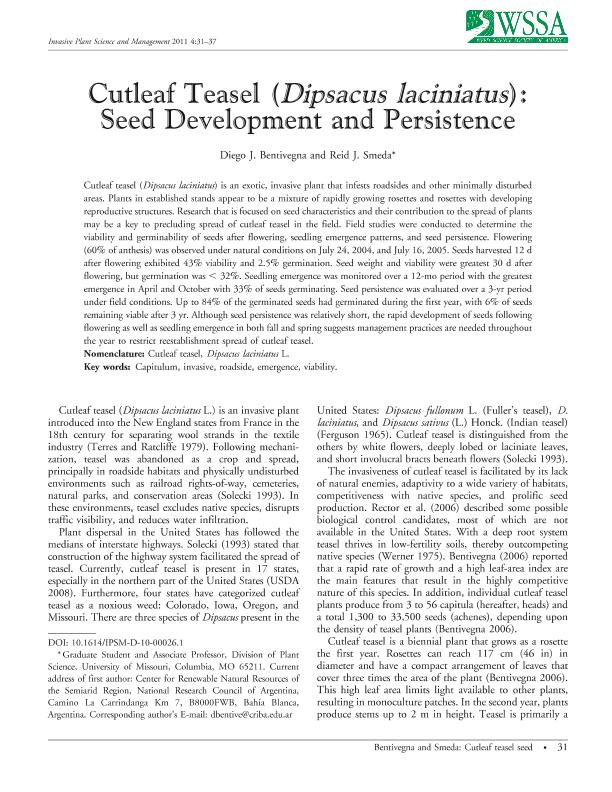Artículo
Cutleaf teasel (Dipsacus laciniatus): seed development and persistence
Fecha de publicación:
01/2011
Editorial:
Weed Science Society of America
Revista:
Invasive Plant Science and Management
ISSN:
1939-7291
e-ISSN:
1939-747X
Idioma:
Inglés
Tipo de recurso:
Artículo publicado
Clasificación temática:
Resumen
Cutleaf teasel (Dipsacus laciniatus) is an exotic, invasive plant that infests roadsides and other minimally disturbed areas. Plants in established stands appear to be a mixture of rapidly growing rosettes and rosettes with developing reproductive structures. Research that is focused on seed characteristics and their contribution to the spread of plants may be a key to precluding spread of cutleaf teasel in the field. Field studies were conducted to determine the viability and germinability of seeds after flowering, seedling emergence patterns, and seed persistence. Flowering (60% of anthesis) was observed under natural conditions on July 24, 2004, and July 16, 2005. Seeds harvested 12 d after flowering exhibited 43% viability and 2.5% germination. Seed weight and viability were greatest 30 d after flowering, but germination was <32%. Seedling emergence was monitored over a 12-mo period with the greatest emergence in April and October with 33% of seeds germinating. Seed persistence was evaluated over a 3-yr period under field conditions. Up to 84% of the germinated seeds had germinated during the first year, with 6% of seeds remaining viable after 3 yr. Although seed persistence was relatively short, the rapid development of seeds following flowering as well as seedling emergence in both fall and spring suggests management practices are needed throughout the year to restrict reestablishment spread of cutleaf teasel. © Weed Science Society of America.
Palabras clave:
Capitulum
,
Invasive
,
Roadside
,
Emergence
,
Viability
Archivos asociados
Licencia
Identificadores
Colecciones
Articulos(CERZOS)
Articulos de CENTRO REC.NAT.RENOVABLES DE ZONA SEMIARIDA(I)
Articulos de CENTRO REC.NAT.RENOVABLES DE ZONA SEMIARIDA(I)
Citación
Bentivegna, Diego Javier; Smeda, Reid J.; Cutleaf teasel (Dipsacus laciniatus): seed development and persistence; Weed Science Society of America; Invasive Plant Science and Management; 4; 1; 1-2011; 31-37
Compartir
Altmétricas




